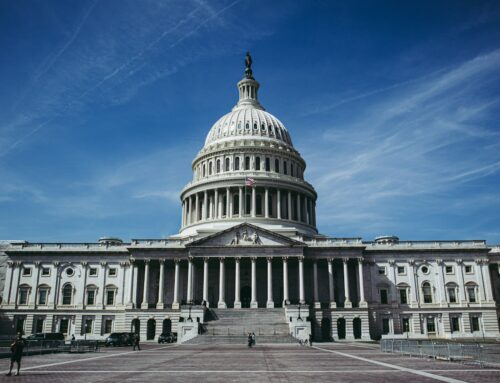This brief provides an overview of a recent letter from the Congressional Budget Office (CBO) to the Chairman and Ranking Member of the U.S. House of Representatives Committee on the Budget describing the implementation of the Fiscal Responsibility Act of 2023 (FRA). It explains the potential enforcement of spending caps through a process called sequestration, which would result in across-the-board reductions if spending exceeds the limits. The CBO outlines the uncertainty surrounding the effects of these caps, noting that future legislation and decisions by the Office of Management and Budget (OMB) will be crucial in determining the actual impact on discretionary funding.
Context
Congressional leaders have reportedly reached agreement on the overall spending levels for fiscal year 2024, which is a crucial first step towards avoiding a government shutdown. The deal establishes an overall spending level of $1.59 trillion, with $886 billion allocated for the military and $704 billion for nondefense spending.
The current Continuing Resolution (CR), H.R.6363, was passed by Congress on November 15, 2023, to fund the federal government and avoid a shutdown. This CR funds four appropriations bills through January 19, 2024, and eight appropriations bills through February 2, 2024. The appropriations bills funded until January 19 include Agriculture, Rural Development, and the Food and Drug Administration; Energy and Water Development; Military Construction and Veterans Affairs; and Transportation, Housing, and Urban Development. The remaining appropriations packages are set to expire on February 2. Congress now faces the task of negotiating and writing language, securing passage by both chambers, and getting the first four appropriations bills signed into law before the first deadline.
Fiscal Year 2024 Spending Caps
Spending caps are limits set on the amount of money that can be spent by the government in a given fiscal year. These caps are established by legislation and are enforced by the OMB through a process called sequestration, which involves across-the-board reductions to budgetary resources.
The FRA sets separate caps on defense funding and nondefense funding. The caps for 2024 are specified in two sections of the FRA, each resulting in different outcomes for funding:
- Section 102 sets the caps on defense and nondefense funding at 1 percent below the CBO estimate of defense and nondefense base funding as provided in the Consolidated Appropriations Act, 2023. The amounts in the CAA, 2023, are $858 billion for defense and $744 billion for nondefense activities—so the section 102 caps for 2024 are $850 billion for defense and $736 billion for nondefense funding.
- Section 101 specifies caps for 2024 of $886 billion for defense and $704 billion for nondefense funding.
The set of caps that applies to discretionary funding depends on the timing of the enactment of appropriation acts and the duration for which funding is provided. If all full-year appropriations have not been enacted by April 30, 2024, OMB will use the section 102 caps to determine whether sequestration is required. Within 15 days of the enactment of the last full-year appropriation act, OMB will use the section 101 caps to determine whether sequestration is required.
Sequestration
Sequestration begins with OMB comparing its estimates of defense and nondefense discretionary funding provided for a given fiscal year with the spending caps specified in the relevant legislation. In the case of the FRA, these caps are set for defense and nondefense funding.
If OMB determines that funding for one or both categories exceeds the relevant cap, the President must issue a sequestration order to close the gap. First, OMB decides how each budgetary account is treated under the statutory rules for sequestration. OMB then determines the amount of funding subject to sequestration, which differs from the amount estimated to have exceeded the caps.
Some categories of spending that can cause a breach are not subject to sequestration, while others that cannot cause a breach are subject to such action. For example, funding for programs administered by the Department of Veterans Affairs is exempt from sequestration. However, base discretionary funding for these activities is considered in the determination of whether total base funding complies with the caps. So, excluding these programs from sequestrable resources increases the size of the cuts that would be imposed on other discretionary programs.
The OMB’s estimates of a breach of the caps and the amount of sequestrable funds may differ from those of the CBO. Some differences will stem from differences in baseline projections or budget concepts, and some factors may change between now and the time at which OMB might be required to prepare a sequestration order.
The political implications are significant because the spending caps and the subsequent enforcement through sequestration can have a substantial impact on government operations and services. The CBO’s letter indicates that there is considerable uncertainty regarding the effects of these caps, as they will ultimately depend on future actions by lawmakers and decisions made by the OMB.
The CBO also highlights the potential for differences between the CBO’s and OMB’s estimates of budgetary resources and the need for sequestration, which could lead to negotiation. Lawmakers have the power to influence the outcomes by enacting legislation that could provide different funding amounts, cancel previously provided budget authority, waive or alter the caps, or specify adjustments to the caps.
To avoid a partial or full government shutdown, Congress needs to pass all 12 appropriations bills through both chambers and get them signed by the President before the respective deadlines. This could be done by enacting each bill individually, or by packaging them together through an omnibus or minibus. If Congress fails to enact some or all 12 appropriations bills, federal agencies must cease all non-essential functions until Congress acts, leading to a partial or full government shutdown.











Get Social